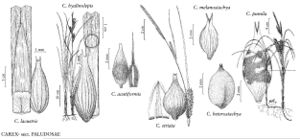Difference between revisions of "Carex melanostachya"
Sp. Pl. 4(1): 299. 1805.
FNA>Volume Importer |
imported>Volume Importer |
||
| (5 intermediate revisions by 2 users not shown) | |||
| Line 6: | Line 6: | ||
|place=4(1): 299. 1805 | |place=4(1): 299. 1805 | ||
|year=1805 | |year=1805 | ||
| + | }} | ||
| + | |special_status={{Treatment/ID/Special_status | ||
| + | |code=I | ||
| + | |label=Introduced | ||
| + | }}{{Treatment/ID/Special_status | ||
| + | |code=F | ||
| + | |label=Illustrated | ||
}} | }} | ||
|basionyms= | |basionyms= | ||
| Line 23: | Line 30: | ||
|elevation=100–300 m | |elevation=100–300 m | ||
|distribution=Kans.;Nebr.;Okla.;Eurasia. | |distribution=Kans.;Nebr.;Okla.;Eurasia. | ||
| + | |introduced=true | ||
|discussion=<p><i>Carex melanostachya</i> is a rare introduction from Eurasia, first discovered in the flora in Kansas in 1964 (R. L. McGregor et al. 1972). A previous report, as <i>C. nutans</i> Host, from the Montreal area is based on sterile specimens suspected to be of hybrid origin (J. Cayouette and P. M. Catling 1992). A similar taxon, C. songorica subsp. gotoi (Ohwi) Popov [C. gotoi Ohwi] was found once as a waif in Yonkers, New York, in 1895. It differs from <i>C. melanostachya</i> in having perigynia that are shorter, only 3–4 mm, shiny, purplish, and have raised veins.</p> | |discussion=<p><i>Carex melanostachya</i> is a rare introduction from Eurasia, first discovered in the flora in Kansas in 1964 (R. L. McGregor et al. 1972). A previous report, as <i>C. nutans</i> Host, from the Montreal area is based on sterile specimens suspected to be of hybrid origin (J. Cayouette and P. M. Catling 1992). A similar taxon, C. songorica subsp. gotoi (Ohwi) Popov [C. gotoi Ohwi] was found once as a waif in Yonkers, New York, in 1895. It differs from <i>C. melanostachya</i> in having perigynia that are shorter, only 3–4 mm, shiny, purplish, and have raised veins.</p> | ||
|tables= | |tables= | ||
| Line 32: | Line 40: | ||
-->{{#Taxon: | -->{{#Taxon: | ||
name=Carex melanostachya | name=Carex melanostachya | ||
| − | |||
|authority=M. Bieberstein ex Willdenow | |authority=M. Bieberstein ex Willdenow | ||
|rank=species | |rank=species | ||
| Line 47: | Line 54: | ||
|publication title=Sp. Pl. | |publication title=Sp. Pl. | ||
|publication year=1805 | |publication year=1805 | ||
| − | |special status= | + | |special status=Introduced;Illustrated |
| − | |source xml=https:// | + | |source xml=https://bitbucket.org/aafc-mbb/fna-data-curation/src/2e0870ddd59836b60bcf96646a41e87ea5a5943a/coarse_grained_fna_xml/V23/V23_919.xml |
|genus=Carex | |genus=Carex | ||
|section=Carex sect. Paludosae | |section=Carex sect. Paludosae | ||
Latest revision as of 20:44, 5 November 2020
Plants colonial; rhizomes long-creeping. Culms central, slender, trigonous, 25–65 cm, ± scabrous-angled. Leaves: basal sheaths reddish purple, apex of inner band finely ciliate; ligules 0.7–1.9 mm; blades green, M-shaped, not septate-nodulose, 1.6–3.5(–4) mm wide, smooth abaxially, glabrous or, sometimes, lightly pubescent on apex of inner band of distal sheaths. Inflorescences 6–20 cm; rachis beyond proximal pistillate spikes sharp-angled, finely scabrous; proximal (1–)2(–3) spikes pistillate, not or barely overlapping, ascending; distal spikes erect; terminal 1–3 spikes staminate. Pistillate scales ovate, apex acute to acuminate-awned, glabrous, scabrous-ciliate apically. Perigynia ascending, ca. 14–18-veined near base, veins impressed, broadly ovoid, (4–)4.5–6.5 × 1.9–3.5 mm, dull, glabrous; beak 0.9–1.3 mm, bidentulate, teeth straight, 0.5–0.8 mm.
Phenology: Fruiting May–Jun.
Habitat: Ruderal in moist to wet roadside ditches and waste areas
Elevation: 100–300 m
Distribution

Introduced; Kans., Nebr., Okla., Eurasia.
Discussion
Carex melanostachya is a rare introduction from Eurasia, first discovered in the flora in Kansas in 1964 (R. L. McGregor et al. 1972). A previous report, as C. nutans Host, from the Montreal area is based on sterile specimens suspected to be of hybrid origin (J. Cayouette and P. M. Catling 1992). A similar taxon, C. songorica subsp. gotoi (Ohwi) Popov [C. gotoi Ohwi] was found once as a waif in Yonkers, New York, in 1895. It differs from C. melanostachya in having perigynia that are shorter, only 3–4 mm, shiny, purplish, and have raised veins.
Selected References
None.
